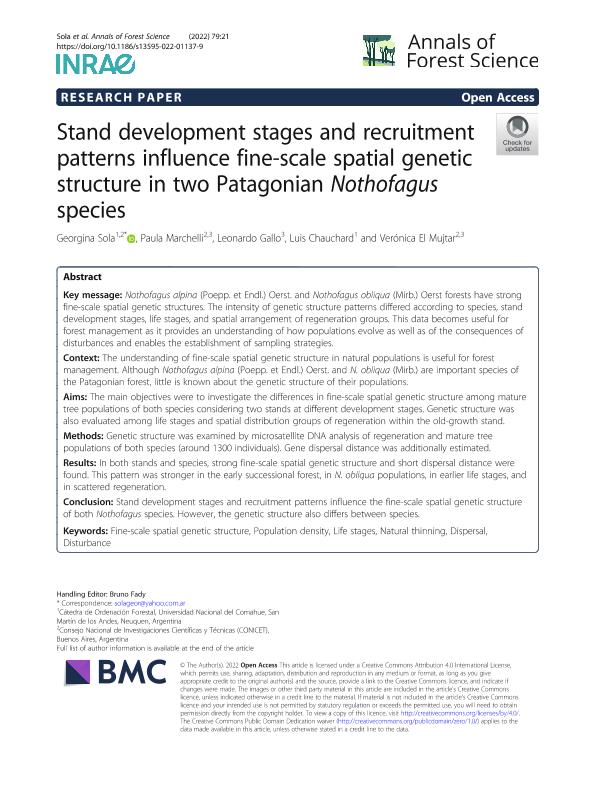Mostrar el registro sencillo del ítem
dc.contributor.author
Sola, Georgina Giselle

dc.contributor.author
Marchelli, Paula

dc.contributor.author
Gallo, Leonardo

dc.contributor.author
Chauchards, Luis Mario

dc.contributor.author
El Mujtar, Verónica Andrea

dc.date.available
2023-10-31T12:16:45Z
dc.date.issued
2022-12
dc.identifier.citation
Sola, Georgina Giselle; Marchelli, Paula; Gallo, Leonardo; Chauchards, Luis Mario; El Mujtar, Verónica Andrea; Stand development stages and recruitment patterns influence fine-scale spatial genetic structure in two Patagonian Nothofagus species; EDP Sciences; Annals of Forest Science; 79; 1; 12-2022; 1-15
dc.identifier.issn
1286-4560
dc.identifier.uri
http://hdl.handle.net/11336/216514
dc.description.abstract
Key message: Nothofagus alpina (Poepp. et Endl.) Oerst. and Nothofagus obliqua (Mirb.) Oerst forests have strong fine-scale spatial genetic structures. The intensity of genetic structure patterns differed according to species, stand development stages, life stages, and spatial arrangement of regeneration groups. This data becomes useful for forest management as it provides an understanding of how populations evolve as well as of the consequences of disturbances and enables the establishment of sampling strategies. Context: The understanding of fine-scale spatial genetic structure in natural populations is useful for forest management. Although Nothofagus alpina (Poepp. et Endl.) Oerst. and N. obliqua (Mirb.) are important species of the Patagonian forest, little is known about the genetic structure of their populations. Aims: The main objectives were to investigate the differences in fine-scale spatial genetic structure among mature tree populations of both species considering two stands at different development stages. Genetic structure was also evaluated among life stages and spatial distribution groups of regeneration within the old-growth stand. Methods: Genetic structure was examined by microsatellite DNA analysis of regeneration and mature tree populations of both species (around 1300 individuals). Gene dispersal distance was additionally estimated. Results: In both stands and species, strong fine-scale spatial genetic structure and short dispersal distance were found. This pattern was stronger in the early successional forest, in N. obliqua populations, in earlier life stages, and in scattered regeneration. Conclusion: Stand development stages and recruitment patterns influence the fine-scale spatial genetic structure of both Nothofagus species. However, the genetic structure also differs between species.
dc.format
application/pdf
dc.language.iso
eng
dc.publisher
EDP Sciences

dc.rights
info:eu-repo/semantics/openAccess
dc.rights.uri
https://creativecommons.org/licenses/by/2.5/ar/
dc.subject
DISPERSAL
dc.subject
DISTURBANCE
dc.subject
FINE-SCALE SPATIAL GENETIC STRUCTURE
dc.subject
LIFE STAGES
dc.subject
NATURAL THINNING
dc.subject
POPULATION DENSITY
dc.subject.classification
Genética y Herencia

dc.subject.classification
Ciencias Biológicas

dc.subject.classification
CIENCIAS NATURALES Y EXACTAS

dc.subject.classification
Conservación de la Biodiversidad

dc.subject.classification
Ciencias Biológicas

dc.subject.classification
CIENCIAS NATURALES Y EXACTAS

dc.title
Stand development stages and recruitment patterns influence fine-scale spatial genetic structure in two Patagonian Nothofagus species
dc.type
info:eu-repo/semantics/article
dc.type
info:ar-repo/semantics/artículo
dc.type
info:eu-repo/semantics/publishedVersion
dc.date.updated
2023-10-30T17:59:50Z
dc.journal.volume
79
dc.journal.number
1
dc.journal.pagination
1-15
dc.journal.pais
Francia

dc.journal.ciudad
Paris
dc.description.fil
Fil: Sola, Georgina Giselle. Universidad Nacional del Comahue. Facultad de Cs.agrarias. Cátedra de Ordenación Forestal; Argentina. Consejo Nacional de Investigaciones Científicas y Técnicas. Centro Científico Tecnológico Conicet - Patagonia Norte; Argentina
dc.description.fil
Fil: Marchelli, Paula. Instituto Nacional de Tecnología Agropecuaria. Centro Regional Patagonia Norte. Estación Experimental Agropecuaria San Carlos de Bariloche. Instituto de Investigaciones Forestales y Agropecuarias Bariloche. - Consejo Nacional de Investigaciones Científicas y Técnicas. Centro Científico Tecnológico Conicet - Patagonia Norte. Instituto de Investigaciones Forestales y Agropecuarias Bariloche; Argentina
dc.description.fil
Fil: Gallo, Leonardo. Instituto Nacional de Tecnología Agropecuaria. Centro Regional Patagonia Norte. Estación Experimental Agropecuaria San Carlos de Bariloche. Instituto de Investigaciones Forestales y Agropecuarias Bariloche. - Consejo Nacional de Investigaciones Científicas y Técnicas. Centro Científico Tecnológico Conicet - Patagonia Norte. Instituto de Investigaciones Forestales y Agropecuarias Bariloche; Argentina. Instituto Nacional de Tecnología Agropecuaria. Centro Regional Patagonia Norte. Estación Experimental Agropecuaria San Carlos de Bariloche. Grupo de Genética Forestal; Argentina
dc.description.fil
Fil: Chauchards, Luis Mario. Universidad Nacional del Comahue. Asentamiento Universidad San Martín de Los Andes; Argentina. Universidad Nacional del Comahue. Facultad de Cs.agrarias. Cátedra de Ordenación Forestal; Argentina
dc.description.fil
Fil: El Mujtar, Verónica Andrea. Instituto Nacional de Tecnología Agropecuaria. Centro Regional Patagonia Norte. Estación Experimental Agropecuaria San Carlos de Bariloche. Instituto de Investigaciones Forestales y Agropecuarias Bariloche. - Consejo Nacional de Investigaciones Científicas y Técnicas. Centro Científico Tecnológico Conicet - Patagonia Norte. Instituto de Investigaciones Forestales y Agropecuarias Bariloche; Argentina
dc.journal.title
Annals of Forest Science

dc.relation.alternativeid
info:eu-repo/semantics/altIdentifier/url/https://annforsci.biomedcentral.com/articles/10.1186/s13595-022-01137-9
dc.relation.alternativeid
info:eu-repo/semantics/altIdentifier/doi/http://dx.doi.org/10.1186/s13595-022-01137-9
Archivos asociados
